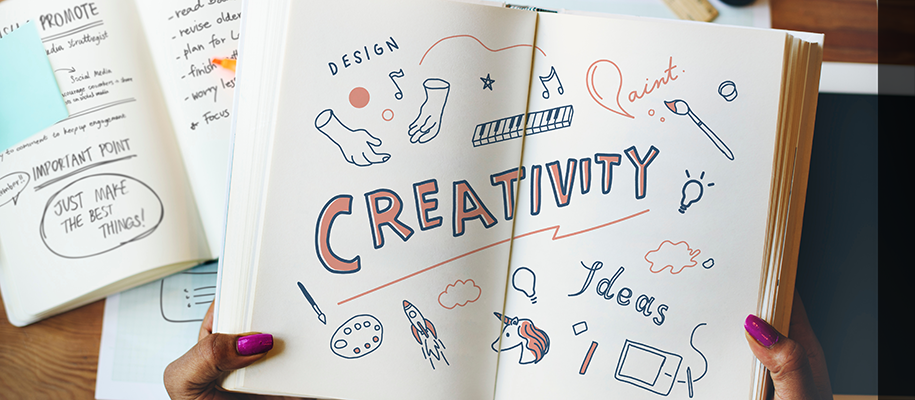From reading novels and writing critical essays to completing lab projects and solving equations, school can be all-consuming for students. Most of the hours in a day are spent pursuing a passing grade on your next big exam. Then there are other obligations such as part-time jobs, child care, and family responsibilities. During a hectic semester, who in the world has time for journaling, quilting, creating a mosaic masterpiece, or crafting an acrylic landscape on canvas? The answer could be anyone who is slightly introspective and knows the intrinsic value of creative power—a force that holistically integrates the mind, body, and spirit.
This gives rise to the potential for balanced productivity in all areas of life, including academic endeavors. Yet multitudes of awe-inspiring creative projects are placed on the back burner or, even worse, completely excluded from many students’ rigorous weekly routines. To be nudged toward a healthier, more balanced lifestyle that includes creative activities, let’s consider a classic model of the creative process and practical steps to motivate your muse even with the busiest academic schedule.
The science of creativity
A recent study by the National Institute of Health examined the impact of creativity on personal happiness, using 256 undergraduate students and 291 working adults as self-reporting subjects. The data determined that being creative made people happier and had a positive effect on their well-being. It follows logically that if you are happier and more emotionally balanced, you can be more productive, less stressed, and less anxious, leading to improved mental health with clarity of thinking.
If these are just a few of the personal benefits, why wouldn’t your academic life be enhanced as well? Overall, the research concluded that creativity facilitates wellness and, consequently, other meaningful pursuits of interest—including academic studies. Now that the case for including creativity in your busy lifestyle has been highlighted, a plan of action is needed to achieve similar results.
Related: Cultivating a Growth Mindset: How to Embrace Your Unique Creative Abilities
Exploring the four major stages of creativity
Somewhere between what we consciously do and the final product is an immeasurable gap filled by the act of producing—this is thought to be your imagination, without which creativity could not exist. It is asserted that the more your imagination is activated and used, the more that cognition, memory, and other brain functions are enhanced and contribute to the creative process.
One famous explanation of this creative process was developed in 1926 by English scholar Graham Wallas. The foundational validity of his proposal has withstood the test of time and infiltrated many current postulates and theories related to the shared functions of brain hemispheres, imagination, and cognition. He broke this theory down into four stages:
- Preparation: This stage involves information sourcing, investigation, and gathering specific ideas and materials for tasks with end goals in mind.
- Incubation: This is characterized by pondering project-related information, some of which will come spontaneously from the subconscious or the imagination. At this point, you should be making new connections and expanding boundaries without limitations.
- Illumination: Here’s where you line up your ideas in a more ordered way to give structure to your plan and objectives. It also usually triggers a highly motivated desire or inspiration to work and create.
- Verification: This is where your final product is in view, and its actualization brings a sense of satisfaction, accomplishment, and closure with inspiration to repeat the process for another emotional reward.
Related: Making Time for Things You Love: How to Mix Schoolwork With Your Passions
How to strategize creative projects
We know the essential value of creative projects, and now that you understand the creative process a little better, here are five strategies you can employ during your busy student life to make passion projects happen in a practical way.
Develop your plan
Whatever pursuit you’re trying to tackle, include your project plan in your weekly schedule, regardless of whether you have time to move forward. Even if you don’t accomplish a set goal, doing something—no matter how small—will get the project ball rolling. For example, you could organize your materials and work area, list resources needed for ideas and guidance, or read some background info on your project topic.
Remember to budget
Determine the estimated expenses for the duration of the project based on your student budget, no matter how big or small. Including this makes it a real part of your lifestyle. If you truly have no money to spare, seek out inexpensive ways to proceed, such as thrifting, finding freebies, or utilizing library access.
Search for resources
Take advantage of the accessibility of social media, YouTube videos, hobby clubs, free membership organizations, and on-campus student groups with similar interests. College and high school students can even start their own clubs and groups to help them stay motivated and connected to the creative path. Seek out opportunities to motivate yourself and express your project plans to others who share your passions.
Related: How to Make Time for Yourself and Your Hobbies With a Busy School Schedule
Ask for help
Never become too independent that you refuse to ask for assistance or advice from free-spirited volunteers, friendly neighbors, accessible experts, friends with shared interests, or kind individuals closely connected to your social circle. You may be pleasantly surprised by the valuable suggestions or material support you can receive by just asking. Many folks love to help a creative spirit!
Forge ahead
Be determined to make weekly progress on your project. Whether it’s after you’re done studying during the week, on the weekends, or in conjunction with other academic tasks, be creative in the planning itself to figure out a way to make it happen. You could improvise by simultaneously intertwining a study session or chore with part of your creative project.
Manage your expectations
Don’t expect huge and constant strides for your project when you also have academic burdens; the key here is consistent incremental progress. Small steps will heal and subconsciously comfort you through the continual expression of the creative spirit. The fulfillment gained through the time spent in the creative process is more wholistically unifying for the body, mind, and soul than the sense of accomplishment at the end of the project.
Related: Procrastination: Your Top Secret Solution to Better Schoolwork and Creativity
If your purpose is to make creative endeavors your way of life, then supporting your innermost self with outward manifestations of your treasured ideas is crucially important. If you find the discipline to continue, you’ll see positive changes that impact your well-being and enhance your academic performance. It’s all a balancing act that you can master with persistent effort!
Find out how Learner can help you with academics. You can also start to envision where your imagination can take you with these 6 Career Paths for People Who Want to Use Their Creativity.








